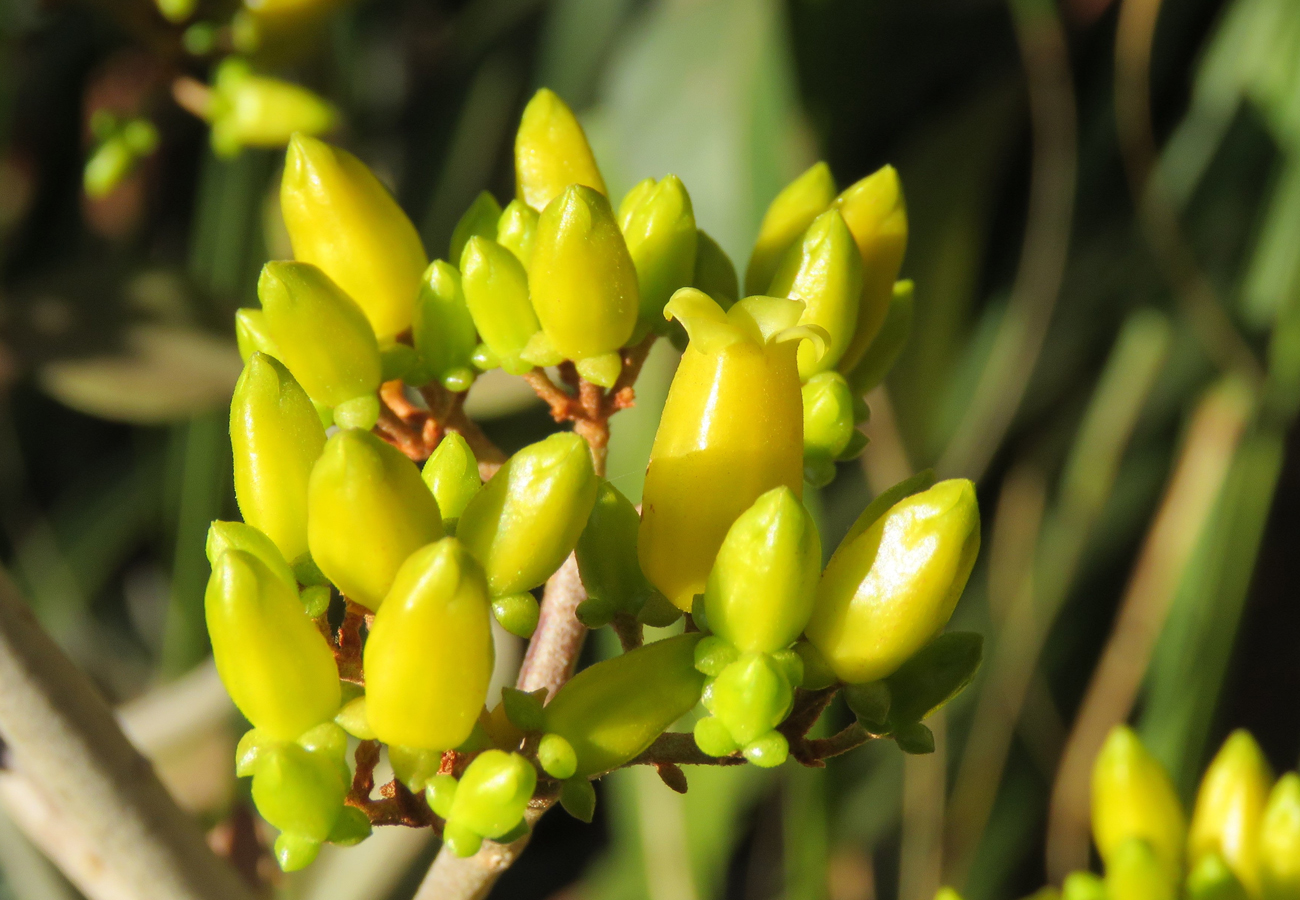Abstract
When describing Kalanchoe orgyalis Baker (1882: 110) [Crassulaceae subfam. Kalanchooideae, Kalanchoe Adanson (1763: 248) subg. Kalanchoe] (Figs 1 & 2), Baker cited two collections, “Baron 105! 249!”, both of which were therefore collected by Reverend Richard Baron (1847–1907), with both presumably originating from “West Betsileo, on stony ground and about woods” (Baker 1882: 110), in Madagascar. Baron, at the time a missionary with the London Missionary Society, spent about 35 years in Madagascar and, apart from his evangelical work, was also a proficient naturalist (Dorr 1997: 28–29, Smith & Figueiredo 2021a). Herbarium material that Baron collected in Madagascar mostly made its way to the Royal Botanic Gardens, Kew, from where the novel material was described (Smith & Figueiredo 2021a: 195).
References
Baker, J.G. (1882) Contributions to the flora of central Madagascar (continued from p. 70 and to be continued). Journal of Botany, British and Foreign. London 20: 109–114. [https://www.biodiversitylibrary.org/item/35873#page/125/mode/1up]
Berger, A. (1930 [Mai]) Crassulaceae. Unterfam. II. Kalanchoideae [sic, Kalanchooideae]. 6. Kalanchoe Adanson. 7. Kitchingia Baker. 8. Bryophyllum Salisb. In: Engler, A. & Prantl, K. (Eds.) Die Natürlichen Pflanzenfamilien, edn 2, 18a. Verlag von Wilhelm Engelmann, Leipzig, pp. 402–412.
Boiteau, P. & Allorge-Boiteau, L. (1995) Kalanchoe (Crassulacées) de Madagascar. Systématique, écophysiologie et phytochimie. ICSN, CNRS, 91198 Gif-sur-Yvette, Éditions Karthala, Paris, 252 pp.
Descoings, B. (2003) Kalanchoe. In: Eggli, U. (Ed.) Illustrated handbook of succulent plants: Crassulaceae. Springer Verlag, Berlin, pp. 143–181.
Dorr, L.J. (1997) Plant collectors in Madagascar and the Comoro Islands. A biographical and bibliographical guide to individuals and groups who have collected herbarium material of algae, bryophytes, fungi, lichens, and vascular plants in Madagascar and the Comoro Islands. The Trustees, Royal Botanic Gardens, Kew, 524 pp.
Drake del Castillo, E. (1903) Note sur les plantes recueillies par M. Guillaume Grandidier dans le sud de Madagascar, en 1898 et 1901. Bulletin du Muséum d’Histoire Naturelle 9: 35–46. [https://www.biodiversitylibrary.org/page/42893852#page/45/mode/1up]
Hamet, R. (1907) Monographie du genre Kalanchoe. Bulletin de l’Herbier Boissier, sér. 2 7: 869–900. [https://www.biodiversitylibrary.org/item/105267#page/939/mode/1up]
Hamet, R. (1908) Monographie du genre Kalanchoe (Suite et fin.). Bulletin de l’Herbier Boissier, sér. 2 8: 17–48. [https://www.biodiversitylibrary.org/item/104945#page/31/mode/1up]
Raymond-Hamet (1915) Sur quelques Kalanchoe de la flore Malgache. I. Bryophyllum crenatum Baker, Kalanchoe laxiflora Baker, Kalanchoe Tieghemi Raymond-Hamet et Kalanchoe crenata Raymond-Hamet. II. Kalanchoe orgyalis Baker et Kalanchoe antanosiana Drake del Castillo. III. Kitchingia porphyrocalyx Baker, Kalanchoe porphyrocalyx Baillon et Kalanchoe sulphurea Baker. IV. Kitchingia campanulata Baker, Kitchingia parviflora Baker, Kitchingia panduriformis Baker, Kitchingia amplexicaulis Baker, Kalanchoe campanulata Baillon. Kalanchoe parviflora Baillon, Kalanchoe panduriformis Baillon et Kalanchoe amplexicaulis Baillon. Annales du Musée Colonial de Marseille, sér. 3, 3: 123–164. [https://www.biodiversitylibrary.org/item/22992#page/145/mode/1up]
Raymond-Hamet & Marnier-Lapostolle, J. (1964) Le genre Kalanchoe au Jardin Botanique “Les Cèdres”. Archives du Muséum National d’Histoire Naturelle Septième Série, Tome VIII: 1–110, Plates I–XXXVII.
Smith, G.F. (2020) The kalanchoes (Crassulaceae subfam. Kalanchooideae) of Raymond-Hamet (1890–1972). Bradleya 38: 120–140. https://doi.org/10.25223/brad.n38.2020.a15
Smith, G.F. & Figueiredo, E. (2021a) The taxonomy and nomenclature of Kalanchoe streptantha Baker (Crassulaceae subfam. Kalanchooideae). Bradleya 39: 195–201. https://doi.org/10.25223/brad.n39.2021.a20
Smith, G.F. & Figueiredo, E. (2021b) (2852) Proposal to reject the name Kalanchoe aleurodes (Crassulaceae: Kalanchooideae). Taxon 70 (6): 1371–1372. https://doi.org/10.1002/tax.12632
Stearn, W.T. (1931 [15 June]) Notes from the University Herbarium, Cambridge. I. A new Rhodesian Kalanchoe. The Journal of Botany, British and Foreign LXIX [69]: 164–165.
Turland, N.J., Wiersema, J.H., Barrie, F.R., Greuter, W., Hawksworth, D.L., Herendeen, P.S., Knapp, S., Kusber, W.-H., Li, D.-Z., Marhold, K., May, T.W., McNeill, J., Monro, A.M., Prado, J., Price, M.J. & Smith, G.F. (2018) International Code of Nomenclature for algae, fungi, and plants (Shenzhen Code) adopted by the Nineteenth International Botanical Congress Shenzhen, China, July 2017. Koeltz Botanical Books, Glashütten. [Regnum Vegetabile 159], 254 pp. https://doi.org/10.12705/Code.2018


